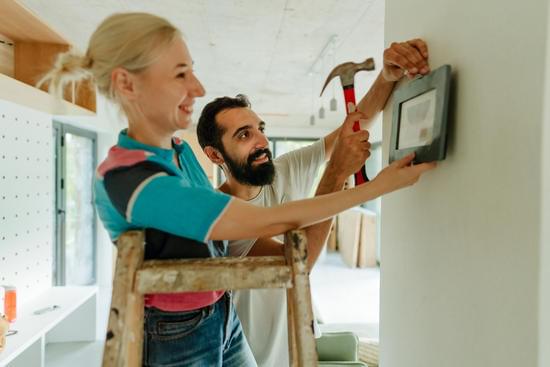Are you wondering, “How much of a home improvement loan can I get?” When it comes to financing your home improvement project, understanding the basics of home improvement loans is crucial. This type of loan differs from other types of loans in terms of eligibility requirements, borrowing limits, and repayment terms. Whether you’re planning a major renovation or just looking to make some upgrades, knowing how much you can borrow is essential for successful planning and execution.
Before diving into the specifics of calculating your maximum loan amount, it’s important to understand the factors that lenders consider when determining your eligibility for a home improvement loan. Your credit score plays a significant role in this process, as it reflects your creditworthiness and ability to repay the borrowed funds. Additionally, factors such as income, employment history, and existing debt will also be taken into account when assessing your eligibility and determining the amount you can borrow.
Once you have a clear understanding of the eligibility criteria and factors that influence your borrowing limit, you can then proceed with calculating the maximum amount you can borrow for your home improvement project. This involves considering various aspects such as the value of your home, the type of improvements you plan to make, and potential collateral that may be required by the lender.
With a step-by-step guide, we’ll walk you through this process to help you determine the most suitable borrowing limit for your specific needs.
Determining Your Eligibility
When applying for a home improvement loan, it’s important to understand the factors that lenders consider when determining how much you can borrow. Your eligibility for a home improvement loan depends on several key factors that lenders take into account during the application process. By understanding these factors, you can better prepare yourself to qualify for the maximum loan amount and secure the financing you need for your renovation project.
Income and Employment
One of the primary considerations that lenders look at when determining your eligibility for a home improvement loan is your income and employment status. Lenders want to ensure that you have a stable source of income to support the repayment of the loan. They will assess your income level, employment history, and any other sources of income or assets you may have. A steady employment history and consistent income are important factors in determining the amount you can borrow.
Debt-to-Income Ratio
Another crucial factor that lenders consider is your debt-to-income ratio (DTI). This ratio measures your total monthly debt payments against your gross monthly income. Lenders use this metric to evaluate your ability to manage additional debt from a home improvement loan while still meeting your existing financial obligations. Generally, a lower DTI suggests that you have more disposable income available to repay a new loan, which may increase the amount you can borrow.
Home Equity
The amount of equity you have in your home can also impact how much you can borrow for a home improvement loan. Home equity is the difference between the current market value of your home and the outstanding balance on your mortgage.
Lenders may use this equity as collateral for the loan, allowing them to offer larger loan amounts at lower interest rates. The more equity you have in your home, the higher the potential borrowing limit for your renovation project.
The Importance of Your Credit Score
Your credit score plays a crucial role in determining the amount of home improvement loan you can qualify for. Lenders use your credit score to assess your creditworthiness and the risk of lending you money. A higher credit score generally makes you a more attractive borrower, increasing the likelihood of being approved for a larger loan amount with more favorable terms.
Understanding Credit Score Requirements
Most lenders have minimum credit score requirements for home improvement loans. While these requirements can vary, a good to excellent credit score is typically necessary to qualify for the highest loan amounts and best interest rates. It’s important to review your credit report for any errors or issues that could be negatively impacting your score before applying for a home improvement loan.
Impact on Loan Terms and Interest Rates
In addition to influencing the maximum loan amount you can qualify for, your credit score also affects the terms and interest rates you may be offered. Borrowers with higher credit scores are likely to receive lower interest rates and may have access to more favorable repayment terms. Conversely, those with lower credit scores may face higher interest rates and less flexible terms, making it essential to work on improving their creditworthiness before applying for a home improvement loan.
Improving Your Credit Score
If your credit score is currently lower than what is typically required for the maximum home improvement loan amount, there are steps you can take to improve it over time. These include paying bills on time, reducing outstanding debt, and avoiding opening new lines of credit unnecessarily. Additionally, reviewing your credit report regularly can help identify areas where improvements can be made to strengthen your overall financial profile and increase your chances of qualifying for a larger home improvement loan.
Calculating Your Loan Amount
When considering a home improvement project, one of the most important steps is determining how much you can borrow for your loan. Calculating your loan amount involves understanding the factors that lenders consider and evaluating your financial situation. Here’s a step-by-step guide to help you calculate the maximum amount you can borrow for your home improvement project.
The first step in calculating your loan amount is to determine the value of your home. This will be a crucial factor in how much you can borrow for your project. The value of your home will help to establish the loan-to-value ratio (LTV), which is used by lenders to determine the maximum amount they are willing to lend you.
After establishing the value of your home, it’s essential to consider your income and existing debts. Lenders will assess your debt-to-income ratio (DTI) to ensure that you have enough income to cover both your existing debts and the additional loan payments. Your DTI will play a significant role in determining how much you can borrow for your home improvement project.
Additionally, it’s important to determine the specific costs associated with your renovation project. By creating a detailed budget that outlines all expenses, including materials, labor, permits, and other fees, you’ll be able to more accurately calculate the amount needed for financing. A thorough budget will not only help in estimating the loan amount but also serve as a useful tool in managing costs throughout the renovation process.
| Factors | Description |
|---|---|
| Home Value | Determines loan-to-value ratio used by lenders |
| Income and Debts | Evaluates debt-to-income ratio considered by lenders |
| Reno Budget | Detailed budget helps in estimating required loan amount |
Types of Home Improvement Loans
When it comes to financing home improvement projects, there are several options available to homeowners. Each type of loan has its own borrowing limits and terms, so it’s important to understand the differences before making a decision.
One common option is a home equity loan, which allows homeowners to borrow against the equity in their homes. The maximum amount that can be borrowed is typically determined by the value of the home and the amount of equity the homeowner has built up. Another option is a home equity line of credit (HELOC), which also allows homeowners to borrow against their home’s equity but functions more like a credit card with a revolving credit limit.
For those who want to take out a loan specifically for home improvements, a personal loan may be an option. Personal loans typically have higher interest rates compared to home equity loans, but they do not require any collateral. Additionally, FHA Title 1 loans are designed specifically for home improvements and have borrowing limits that vary depending on the type of property and the specific project.
It’s important for homeowners to carefully consider each type of loan and evaluate their borrowing limits before deciding on the best option for their needs. By comparing interest rates, terms, and borrowing limits, homeowners can make an informed decision that aligns with their goals for their home improvement project.
| Loan Type | Borrowing Limit |
|---|---|
| Home Equity Loan | Determined by Home Value & Equity |
| HELOC | Revolving Credit Limit |
| Personal Loan | No Collateral; Higher Interest Rates |
| FHA Title 1 Loan | Vary Depending on Property & Project |
Collateral and Loan Limits
When applying for a home improvement loan, one of the key factors that lenders will consider is the value of your home and the loan-to-value (LTV) ratio. The LTV ratio is calculated by dividing the amount of the loan by the appraised value of your home. The higher your LTV ratio, the riskier it is for the lender, which can affect the maximum amount you can borrow.
Here are some important points to consider when it comes to collateral and loan limits for a home improvement loan:
- Home Equity: If you have substantial equity in your home, it can increase your chances of qualifying for a larger loan amount. Equity is the difference between your home’s current market value and any outstanding mortgage balance.
- Lender Requirements: Different lenders may have different requirements when it comes to LTV ratios. Some may be willing to lend up to 80% or more of your home’s value, while others may have lower limits.
- Property Appraisal: Before approving a home improvement loan, lenders will typically require a professional appraisal of your property to determine its current market value.
- Impact on Interest Rates: The LTV ratio can also impact the interest rates offered by lenders. Higher LTV ratios may result in higher interest rates or additional fees.
Understanding how collateral and loan limits impact your ability to borrow for a home improvement project is essential when seeking financing options. Be sure to carefully review these factors when exploring different lenders and loan options to ensure you get the maximum amount you need at terms that work best for you.
Shopping for Lenders
When it comes to shopping for lenders for a home improvement loan, it’s important to explore your options and find the right lender who can offer you the maximum loan amount at the best terms and interest rates. Here are some tips to help you find the most suitable lender for your needs:
- Research and Compare: Take the time to research and compare different lenders offering home improvement loans. Look at their interest rates, loan terms, fees, and customer reviews to get a better understanding of what each lender has to offer.
- Check Your Credit Score: Before approaching lenders, it’s important to check your credit score. A good credit score will not only make you eligible for higher loan amounts but also lower interest rates. This can significantly impact the total cost of your loan over time.
- Ask for Recommendations: Reach out to friends, family, or colleagues who have recently taken out a home improvement loan and ask them about their experiences with different lenders. Personal recommendations can be valuable in finding a reputable lender.
Finding the right lender is crucial as it can impact the overall cost of your home improvement project. By taking the time to shop around and compare different lenders, you can ensure that you get the maximum loan amount at favorable terms and interest rates.
Keep in mind that while getting the maximum loan amount is important, it’s equally essential to consider factors such as customer service, flexibility in repayment options, and any additional perks or benefits offered by the lender when making your decision. These factors can contribute to a positive borrowing experience and ultimately lead to successful completion of your home improvement project.
Putting Your Loan to Work
In conclusion, getting a home improvement loan can be a great way to finance your renovation project and increase the value of your home. However, it is important to use the funds wisely in order to maximize the impact of your renovations. Whether you are doing minor updates or a major remodel, it’s crucial to have a plan for how you will use the loan funds to achieve the best results.
One effective way to utilize the funds from your home improvement loan is to prioritize projects that will add significant value to your home. This could include kitchen or bathroom upgrades, adding additional living space, or improving energy efficiency. By focusing on these types of renovations, you can not only enhance your quality of life but also increase the resale value of your property.
Additionally, it’s important to work with reputable contractors and suppliers when using your home improvement loan funds. Researching and hiring professionals with a proven track record can help ensure that the money is being used efficiently and effectively.
Finally, keeping track of all expenses related to the renovation project will allow you to stay within budget and make any necessary adjustments along the way. By following these strategies, you can make the most of your home improvement loan and achieve the maximum value and impact from your renovations.
Frequently Asked Questions
What Is the Average Length of a Home Improvement Loan?
The average length of a home improvement loan typically ranges from 5 to 30 years, depending on the lender and the specific terms of the loan. Shorter loan terms may have higher monthly payments but lower overall interest costs, while longer loan terms may have lower monthly payments but higher overall interest costs.
Can You Borrow More for Home Improvements?
Yes, it is possible to borrow more for home improvements, especially if the value of the improvements will increase the overall value of the property. Lenders may allow homeowners to borrow based on the improved value of their home rather than just its current appraised value. This can provide additional funds for larger-scale renovations or improvements.
Are Renovation Loans a Good Idea?
Renovation loans can be a good idea for homeowners who want to make significant upgrades to their property but may not have the cash on hand to cover the costs upfront. These loans can provide a way to finance renovations without having to deplete savings or rely on high-interest credit cards.
However, it’s important for borrowers to carefully consider their ability to repay the loan and ensure that the renovations will add sufficient value to justify taking on additional debt.

I’m thrilled to have you here as a part of the Remodeling Top community. This is where my journey as an architect and remodeling enthusiast intersects with your passion for transforming houses into dream homes.





